Soulstone
 Soulstone is a blue crystal formation originally found deep in the Demrefor cave systems. It glows — with larger chunks glowing longer and brighter than smaller chunks — and has a usable energy that enhances magic.
Soulstone is a blue crystal formation originally found deep in the Demrefor cave systems. It glows — with larger chunks glowing longer and brighter than smaller chunks — and has a usable energy that enhances magic.
Soulstone needs to be recharged to be usable, with sunlight being the main method of charging. Some magic-users are able to charge soulstone using their own magic when necessary, although this is not recommended as it can be very draining on the magic user and provides minimal results when compared to sunlight-charged soulstone.
Strangely, soulstone found deep in caves is often brighter-charged than surface soulstone. People reason that, while soulstone is known to draw energy from the sun, when deep enough underground soulstone will draw energy from the planet instead. Evidence seems to show that the deeper the cave the soulstone is found in, the easier it is for the crystal to recharge using Demrefor’s magical energy.
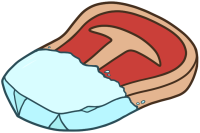 Although soulstone is a safer light source than fire, it is not harmless; it spreads similar to fungus or rust. Slow and persistent, it eats away at flesh, bone, hair, and other natural living fibres that it may be exposed to for elongated periods of time.
Although soulstone is a safer light source than fire, it is not harmless; it spreads similar to fungus or rust. Slow and persistent, it eats away at flesh, bone, hair, and other natural living fibres that it may be exposed to for elongated periods of time.
Diamond, stone, and silver are a few of the things that soulstone cannot eat through, no matter how much time it is given. Things like glass and tin, however, will eventually be eaten through; though it can take up to a year for any effect to be visible.
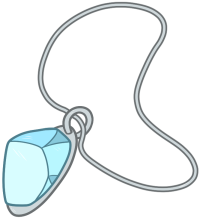 Despite this, soulstone jewellery is surprisingly common. Those who choose to wear soulstone jewellery must be very wary of the maker; cheaper jewellery is often created using glass in place of diamond and if the stone is worn for too long or handled too roughly, the wearer may face the consequences.
Despite this, soulstone jewellery is surprisingly common. Those who choose to wear soulstone jewellery must be very wary of the maker; cheaper jewellery is often created using glass in place of diamond and if the stone is worn for too long or handled too roughly, the wearer may face the consequences.
There is no known way to stop the spread of a soulstone infection once it has begun to eat away at something; magic cannot stop the spread and the soulstone can no longer be uncharged and turned to diamond as it is constantly drawing energy from the object it has fused to.
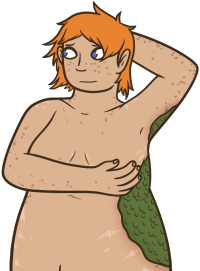 The only way to stop the spread of soulstone is to cut away the infected area; on living creatures, this often involves limb amputation or the scraping of large wounds into the body.
The only way to stop the spread of soulstone is to cut away the infected area; on living creatures, this often involves limb amputation or the scraping of large wounds into the body.
A common treatment while cutting out soulstone is dragon scale grafting; using scales from a dragon’s hide in place of a skin graft. This means the flesh heals harder, even when the person’s skin grows back, and there is less chance of re-infection as most dragons have a natural immunity to soulstone.
Many soulstone caves have frozen statues of ancient travellers and animals who got lost in the caves and collapsed; to be preserved forever in the stone. These sad statues were what earned soulstone its name: it is believed that if you die from a soulstone infection, your soul will be trapped in the rock. The only chance your spirit has of being freed is if the soulstone that trapped you is shattered.
 In the late 11,000s, soulstone was discovered to have electrical properties. It would become more powerful during electrical storms, and it is believed soulstone has a link to powering ancient human and nurlak technology (though nobody has been able to prove this theory).
In the late 11,000s, soulstone was discovered to have electrical properties. It would become more powerful during electrical storms, and it is believed soulstone has a link to powering ancient human and nurlak technology (though nobody has been able to prove this theory).
Until the early 10,000s, soulstone was only used as a sun-charged light source and a magic-enhancing tool; the discovery of memoryshare and warmrock inspired the study of soulstone, which led to new forms of the rock being created.
There was also the discovery of liquid soulstone when an enchanter found a way to destabilise the soulstone’s solid form and liquefy it. This can be done with any colour of soulstone except for clear diamond. When liquid soulstone spreads, whatever it spreads onto becomes solid soulstone.
Diamond
 Diamond is the final, irreversible stage of soulstone; it is when soulstone loses its magical properties and is considered ‘dead’.
Diamond is the final, irreversible stage of soulstone; it is when soulstone loses its magical properties and is considered ‘dead’.
When soulstone is starved of energy long enough for it to completely uncharge, it turns to diamond. Diamond has no magical properties, does not glow, and is harder than regular soulstone crystals.
Diamond cannot be turned back into soulstone.
Blood Moss Stained / Pink Soulstone
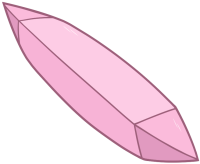 Blood moss stained soulstone has a pink hue to it. It shares most of its properties with regular soulstone. However, pink soulstone charges faster and the charge lasts longer. The glow of pink soulstone is as bright as regular soulstone, though it may feel dimmer due to being a warmer colour.
Blood moss stained soulstone has a pink hue to it. It shares most of its properties with regular soulstone. However, pink soulstone charges faster and the charge lasts longer. The glow of pink soulstone is as bright as regular soulstone, though it may feel dimmer due to being a warmer colour.
This stone is also a lot less aggressive and takes a lot more time to eat away at flesh and blood than regular soulstone.
Memoryshare
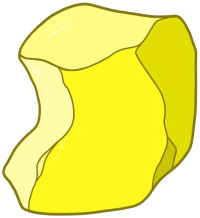 Memoryshare is a yellow variation of soulstone that has been used to store memories and feelings inside it. It is the most studied variation of soulstone besides the natural blue.
Memoryshare is a yellow variation of soulstone that has been used to store memories and feelings inside it. It is the most studied variation of soulstone besides the natural blue.
Memoryshare is made through locking memories into common soulstone, and so it cannot be empty. The only way to destroy the enchantment in a memoryshare stone is to let it die and turn to diamond. Shattering memoryshare doesn’t rid the enchantment; it simply shatters the memory, with different parts of the memory contained in different fragments of the crystal. Depending on how charged the soulstone was when it was used to lock in the memory, the stone can contain anything from vague feelings to specific events with clear images and sound.
Memoryshare can also be used to contain audio recordings, though this enchantment is slightly more difficult than simply locking memories into the stone as the sounds must be played into the stone as it is being enchanted, and then for the stone to produce the sound audibly to more than a single person, it must be played through another object such as an enchanted music box.
The use of audio-only memoryshare was started in the Canis / Sapious war, mostly to relay messages from commanders to troops and record final wishes. It was only after the war that the full potential of memoryshare’s audio capabilities were discovered. A human bard known as Harley Gilmour used memoryshare to record herself singing, and duplicated these stones by playing her recordings into new stones. Harley became internationally famous, with her music initially selling for over 50,000 gold a song. However, within only thirty years recorded music had become common enough that prices dropped to roughly 20 gold per song.
The discovery of memoryshare came in the early 10,000s when two shooting stars landed on the planet. These stars were presented to the royal Canis family, who unlocked their secrets and used their discovery to start the study of soulstone enchantment. The original memoryshare stones are currently owned by Immortal Queen Distro and have very odd properties when compared to regular memoryshare. They are bronze-gold in colour, not lemon yellow, and instead of showing specific memories the stones appear to allow the users to speak to ancient spirits or view events from their own past. There are many arguments about this, with some theories that the original memoryshare stones are actually a different variant of soulstone altogether.
Warmrock
 Warmrock is a brightly coloured, fire-red soulstone variation. It was the first soulstone variation to be created by enchanters and was discovered during early studies of the original memoryshare stones.
Warmrock is a brightly coloured, fire-red soulstone variation. It was the first soulstone variation to be created by enchanters and was discovered during early studies of the original memoryshare stones.
It is comfortably warm to the touch and, unlike most variations of soulstone, it seems unable to eat away at flesh. However it cannot charge in sunlight and dies within 3 months of being enchanted.
It is very popular in wolven countries, often sold to foreigners as a way to keep warm while visiting the chilly climates, and has become a favoured method of heating baths. Otherwise, it does not appear to have any immediate use.
Some enchanters have managed to make a variation of warmrock extremely hot, like coal and fire. This variation of warmrock is known as “burning warmrock” and it is extremely dangerous as it is so hot it burns whatever it touches and any burns made by burning warmrock become soulstone infected. Because of this, burning warmrock is heavily regulated and requires a licence to create and use.
Coldrock
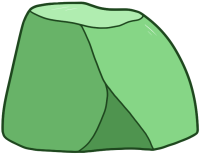 Coldrock is a dark green soulstone variation. Similar to warmrock, it is comfortably cool when held. This soulstone is, however, hyper-aggressive and eats away at flesh at more than triple the speed of regular soulstone.
Coldrock is a dark green soulstone variation. Similar to warmrock, it is comfortably cool when held. This soulstone is, however, hyper-aggressive and eats away at flesh at more than triple the speed of regular soulstone.
When touching water or ice, coldrock produces a cold mist. The mist is harmless to breathe, and so in warmer climates buckets of coldrock and water are hung in houses so the cool mist will flow down and lower the temperature.
Coldrock is also used for food storage. Many households utilise coldrock’s mist to stop meats from going bad, with some variations of coldrock being cold enough to create freezers with.
Dreamcurse
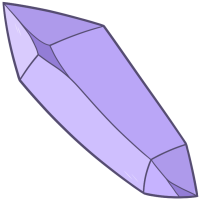 Dreamcurse is a purple-tinted soulstone variation that catches and stores dreams similar to memoryshare.
Dreamcurse is a purple-tinted soulstone variation that catches and stores dreams similar to memoryshare.
Regular soulstone is enchanted with a memoryshare enchantment and hung above the user while they sleep; the stone then locks in the dream of the user. These dreams can then be given to others by placing the dreamcurse stone underneath the sleeper’s pillow.
Dreamcurse was given its name due to its first use; it was created by a seces child in order to give their abusive parents the same reoccurring nightmares they suffered due to their trauma.
Luckcharm
 Luckcharm is a pale white soulstone variation with a dim glow.
Luckcharm is a pale white soulstone variation with a dim glow.
It eats away at flesh slower than regular soulstone and is very pretty, but otherwise does not appear to have any special use.
Luckcharm is believed by many to bring good luck to the owner, but as it cannot be proven most just consider it a decorative form of soulstone that rivals white marble.
Watchcrystal
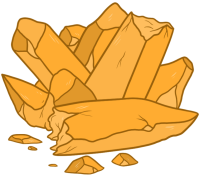 Watchcrystal is the newest recorded soulstone variation. It was officially recorded in the mid 10,600s by the Konde government, but after its discovery was made public research has found evidence that it has been used in the black market trade since the late 10,100s.
Watchcrystal is the newest recorded soulstone variation. It was officially recorded in the mid 10,600s by the Konde government, but after its discovery was made public research has found evidence that it has been used in the black market trade since the late 10,100s.
It is a orange soulstone variation that comes in a large variety of shades, usually indicating the strength of the stone, with a deep orange watchcrystal being stronger than a pale watchcrystal. Watchcrystal is one of the few variations to not absorb organic matter and spread, though it will die if not in contact with a living being for too long.
The crystal is enchanted as a large clump of soulstone, with the main “mother crystal” in the centre. The mother crystal keeps track of the rest of the watchcrystal clump, which is broken up into smaller pieces and attached to jewellery. The jewellery is then used to monitor and control the wearer with sub-enchantments.
The most common enchantments on watchcrystal jewellery are trigger enchantments that respond to location or vocal commands. If a trigger enchantment is activated the watchcrystal will alert the mother crystal and preform any relevant responses.
The enchantments on watchcrystals can range from harmless to cruel; the oldest documented piece of watchcrystal was attached to an enchanted necklace that would choke the wearer if they spoke about certain topics or used specific words. However, at the time of documentation it was not known that this necklace was made from watchcrystal specifically; it simply mentioned “dyed orange soulstone” attached to an enchanted necklace.
Watchcrystal is illegal under the law of the International Alliance with very few exceptions. The only country in the Alliance that has been allowed to make watchcrystal available to the public is Kazzaquin; though all mother crystals must be licensed with the government and used only for the safety of individuals who work in the ice deserts.
Other Soulstone Variants
There are a few soulstone variations that are rumoured to exist but are not officially recognised or documented due to the inability to recreate them. Most reports of these variations come from those who have been in the outer territories or interacted with Mystic races.
A black soulstone variant referred to as “deadener” is reported to have been used by the native coniferie Mystics on Furot to kill soulstone infections. The most credible report is by a nurlak who was shipwrecked on the continent and suffered on infection over the entirety of their right leg. The nurlak reported the coniferie people used black soulstone to suck the life out of the infection, turning it into diamond and saving their life. The credibility of this report comes from the nurlak not removing their diamond leg, even after their return, and though there are a few people who believe that they grafted the diamond leg on themselves for fame it is generally agreed that their report is most likely truthful.